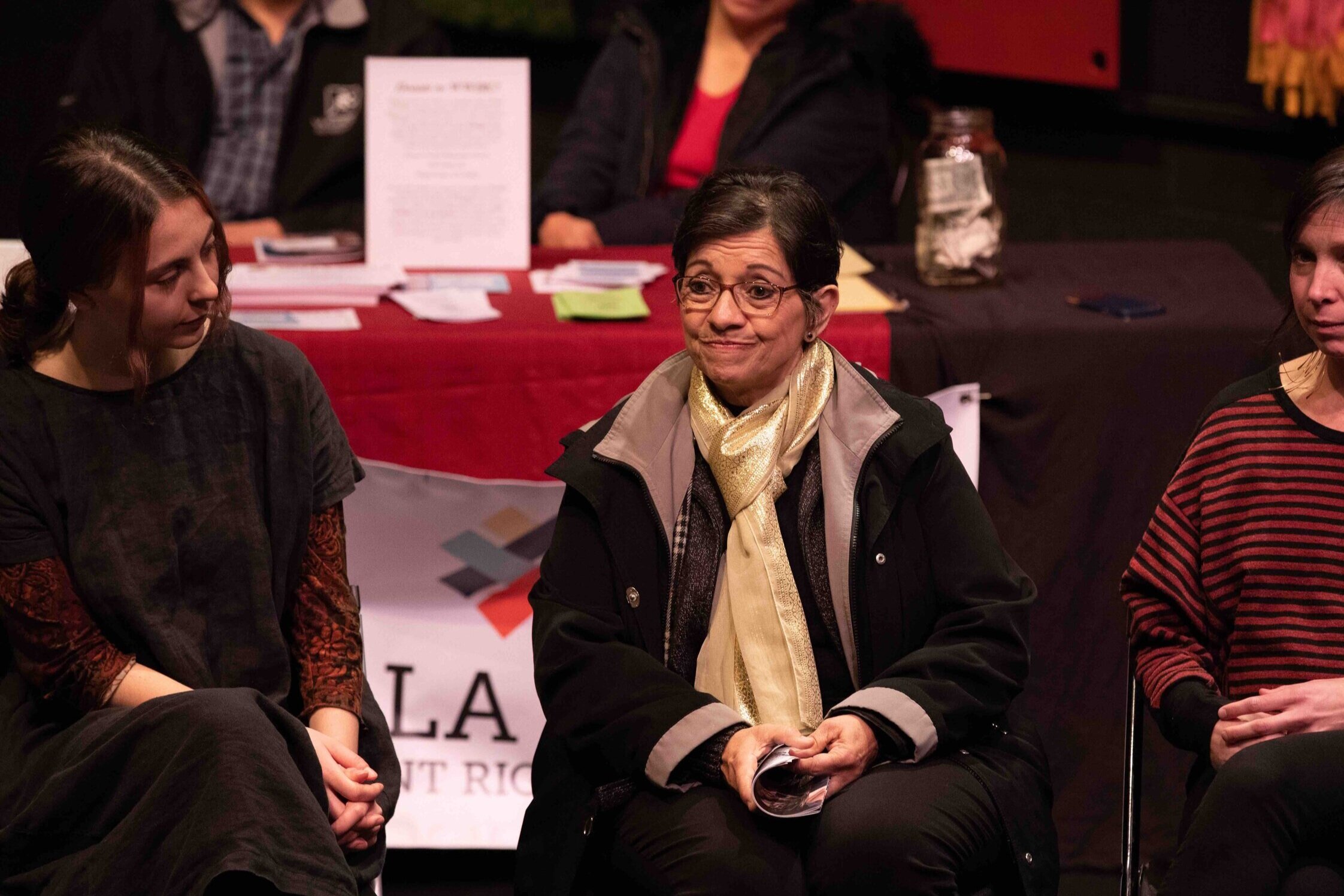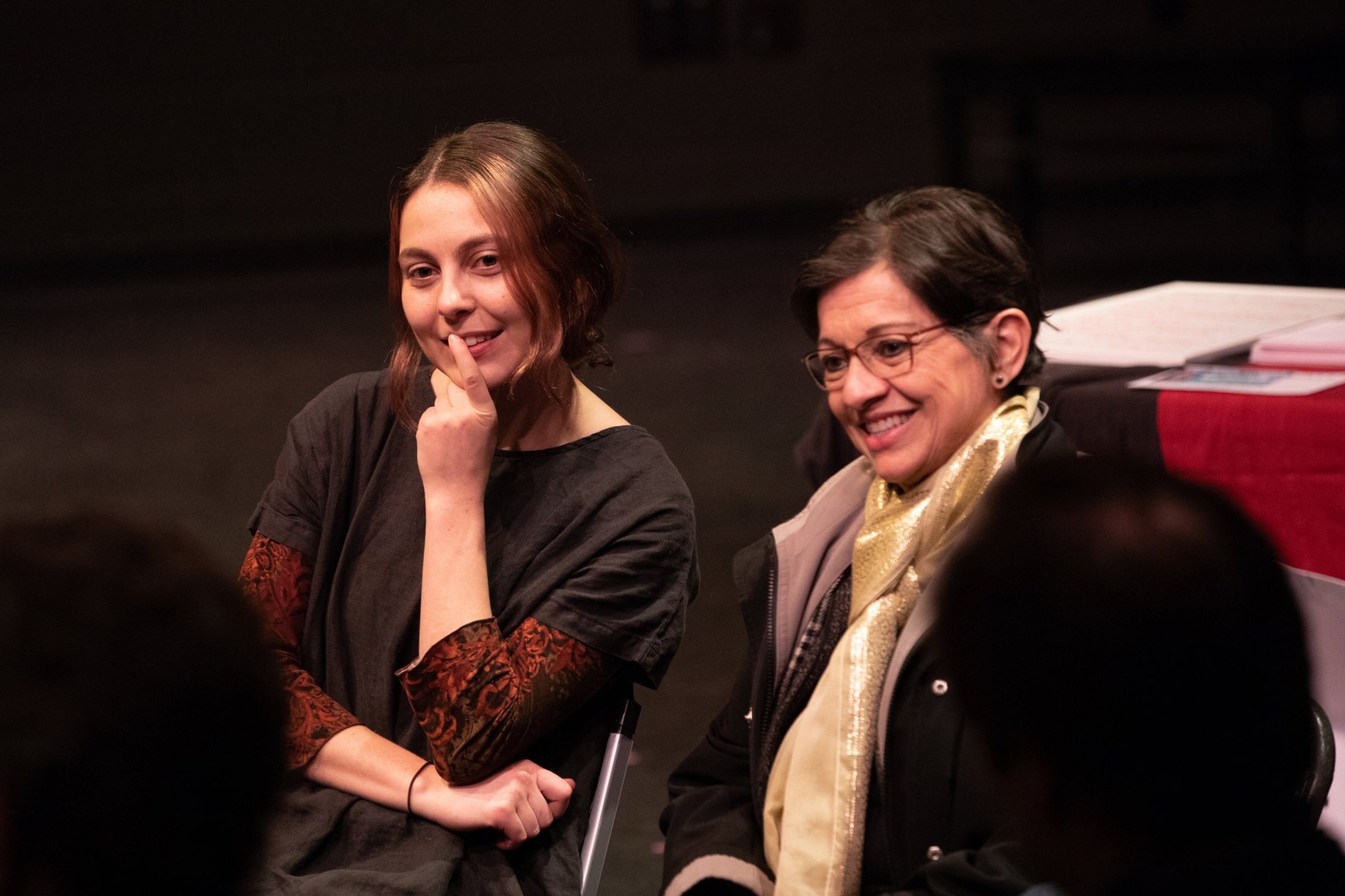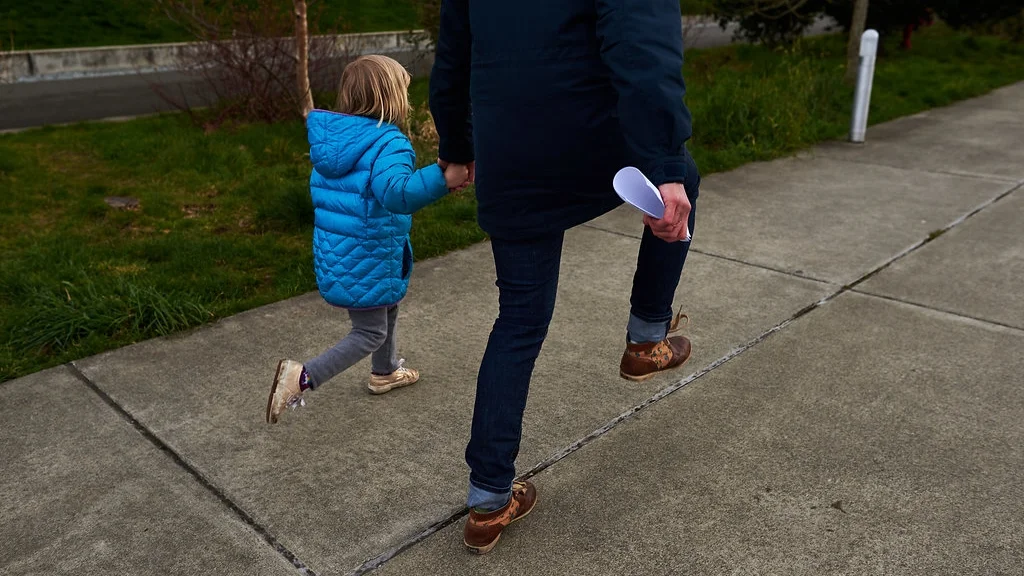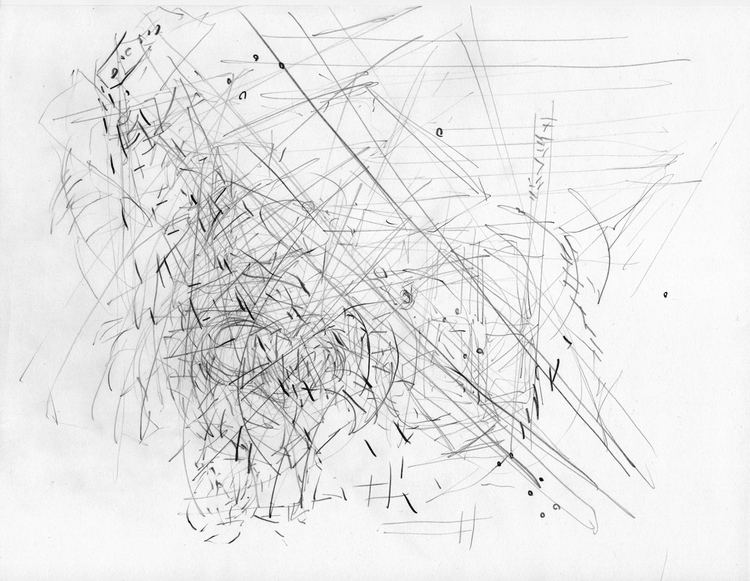After each Because You Are Here performance, audience members were invited onto the stage to listen to a story phone line, HEAR HERE WALLA WALLA, which we created in tandem with the performance as another means to in order to share excerpts from the featured interviews. The audience was also invited to talk with representatives from the Walla Walla Immigrant Rights Coalition, a community organization focused on ensuring the rights of immigrants through education, access to legal counseling and moral and social support services. After the Saturday matinee performance, the cast and a few interviewees who were willing to be identified joined the public for a discussion about the making of the work and the impact of the work on their individual and civic lives.
May this practice be of benefit
As a part of the Because You Are Here process our collaborative team employs rituals to help us transition in and out of rehearsals. We look to these rituals to continually remind us why we are in the room together, to acknowledge each persons contribution and to extend gratitude for everything that made our work together possible. Our collective “clap out” is the most notable of these rituals.
At the end of each rehearsal, we gather together (each and every person in the room is invited to participate). Standing in circle, we all find stillness. In this space we express hope that the work that we do is of benefit. Then, listening to each other (with no individual leader) we all clap our hands at the same time then we throw the clap up sending our hope out into the space.
This ritual has become a glue, tying us to the present moment, the context of our work, and each other. It is often filled with joy, relief, and laughter.
Video filmed by Tia Kramer for a project titled, “I said yes” by collaborator Erina Horikawa
MORE: ACTIONS (from THE LAB)
or find posts from all categories of THE LAB below.
The Red Square
In the process of devising performance, Jessica Cerullo and I have been strongly influenced by the teaching of Barbara Dilley. Dilley, one of Jessica’s mentors at Naropa University, is most known for her development of Contemplative Dance Practice (CDP) a widely used open form movement practice that we employed weekly during the Because You Are Here process. Barbara Dilley also taught a composition technique called “The Red Square” which was invaluable to our student collaborators as it encourages performers to mindfully consider their bodies in relation to the space they inhabit.
A thick red rope “is laid down on the floor, our gaze rests with the room and the Square. Nothing much is happening. Just waiting. Then something comes. “Like a fish leaping from water,” we see in our minds eye a glimpse of our self in a still posture in the Square. We rise up, walk into the Square, and inhabit what we see.” - Barbara Dilley from “This Very Moment: Thinking, Teaching, Dancing" p171
After each person has a chance to try out a Solo once or twice or two dozen times, we began with Duets. “Duets begin with someone in a Solo posture. Because you see that person in the space, where do you see yourself? Go to this image. Settle. Allow a moment for both postures to be seen [by the onlookers and well wishers.] Let the first person ‘peek” after the second one arrives. Let them see what they have inspired! It’s important to acknowledge influences. Now dissolve and leave.” - Barbara Dilley from “This Very Moment: Thinking, Teaching, Dancing" p173
After practice with these forms one can add “allies”-objects, prompts, lights, text and sound. You can also introduce a directors chair in which various participants sit and take on the role of giving out guiding instructions. We also expanded the experimentation into improvisations within the room as a whole in which we respond, moment by moment, to partners and in quartet.
MORE: ACTIONS (from THE LAB)
or find posts from all categories of THE LAB below.
Magic in the mundane?
Over the weekend, I walked with my friend and collaborator Shoshana Gugenheim from the Portland Steel Bridge, on the corner of NW Oregon Street and Interstate Way, to Director's Park in the heart of Portland's downtown. We walked shoulder-to-shoulder, in-step, in silence. Like one entity, my left hand was at my side, still, mirroring hers which rested on a satchel. My right hand felt the momentum or her right hand, together they swayed with intention propelling my feet forward. Right. Left. Right. Left. Both of us keenly aware of the other and our surroundings. Both of us listening and absorbing: The smell of coffee from a cafe on the corner. A woman's perfume. A loud conversation about tomorrow. A crow swooping down to land on the top of a lamp post. I heard the gentle tap of it's claws touching the aluminum armature as a truck passed, thundering down Taylor Street. Negotiating directions and intersections, a change in elevation and traffic felt curious. When we walked beyond each building's shadow, sunshine filled our eyes. Together we squinted. Left and then right. Left then right.
We were experimenting, playing, wondering...actively wandering. How do we inhabit public spaces? What does civic engagement mean? What are the political consequences of our presence? What are the consequences of public silence? What would it be like to walk together, in-step through the bustle of a city? What would it require to remain together? Would anyone notice our unity? What does it mean to combine our efforts? Combine, at it's linguistic origin comes from the prefex "com," which shares it's meaning with "co," means with or together and "bine" means two. Two people. Two sets of arms. Two pairs of legs. Two bodies. Together.
Last February, during our "Walking Tour of the Olympic Sculpture Park," Eric Olson and I publicly shared a set of scores or simple instructions that were set to site-specific sculptures or places throughout the park. Standing on a walking path just a 100 feet from Jaume Plensa's 2011 sculpture Echo we instructed the audience to, "Identify a rhythm in your environment. Using your voice or body, echo this rhythm. Repeat. As we walk toward the sculpture spontaneously repeat."
Photograph by Jonathan Vanderweit. Orbiting Together. Seattle Art Museum Olympic Sculpture Park. 2018
In this period of listening, mirroring and echoing I found myself giggling with Celia, a 4 1/2 year old friend of mine. Her little feet pattered on the pavement with certainty as she grinned up at me. With focus, I smiled back at her and tried (with all my might and attention) to step in sync. My short steps and her big steps, my foot lightly settling to the ground, matching the sound of her confident stomp.
While walking with Shoshana, I recalled this moment. Sometimes the inspiration for my future work is hidden in my body. I only see it when I am brave enough to act on my vision, impulse or intuition.
MORE: ACTIONS (from THE LAB)
or find posts from all categories of THE LAB below.
Sigh. Observe whether anyone noticed. Repeat. (COSMOS 1536)
SENT VIA SATELLITE TRIGGERED TEXT MESSAGE on 1/31/17 at 8:58am.
FACT: COSMOS 1536-Zenit was a series of military spy satellites launched by the Soviet Union between 1961 and 1994. To conceal their nature, all flights were given the public Kosmos (Cosmos) designation. Dozen's of spy satellites orbit overhead daily.
*FEATURED IMAGE is of COSMOS 122: Maquette du satellite météorologique russe (1966), Musée de l'Air et de l'Espace, Paris Le Bourget (France). Obtained on Wikipedia Media Commons
Do you find meaning in these actions?
The week following our Orbiting Together project launch at the SAM Olympic Sculpture Park has been a... learning process. Recently, I heard a colleague say, "The aim is to make a project seem so simple and accessible that it appears as if it could have been pulled off overnight. Yet, the truth of the matter is that the behind the scenes work for these socially engaged projects is belabored." I have been feeling that labor. And because the timeline for this project is breakneck, that labor is exhausting and has taken an emotional toll; maintaining conceptual rigor while maintaining simplicity and clarity has almost been an out of body experience. Given the subject matter and content of the project as a whole, I find that ironic.
All that said, when today's text appeared, I experienced the magic of this project for the first time. I felt as if the words arrived serendipitously, from the cosmos, ESPECIALLY FOR ME. It was personal and intimate. I happened to be standing across from artist and director, Jessica Cerullo, in her vocalization class. She received the text at the same moment, a huge grin filled her face. For some time we sighed as if passing the sigh back and forth in call and response. In between each exhale we slyly looked around the room at the students filing in, carefully observing them. In-the-moment-ness filled our bodies. And then, without saying a word we both went to sit at the circle forming in the middle of the room.
Today, I needed those words. And, based on the participation and feedback, it seems that others needed today's instruction too.
Today, the project felt complete and successful just for what it was.
MORE: ACTIONS (from THE LAB)
or find posts from all categories of THE LAB below.
Rest
Why do you hurry? What are you hurrying toward?
I have come to see the necessity for creative breaks... rest. For the past few months I've intentionally stepped away from the active process of doing my creative work. During this time, I focused on my internal somatic experiences and took the precious moments I typically to fill with creative problem solving, to respond to spontaneous curiosities. I've been reading books, working on our tiny farm of a back yard, chasing my toddler through the sprinkler, watching light refract through the water at the local pool, taking bike rides through wheat fields, meeting with friends, cooking, canning, eating fruit fresh of the tree, sitting, enjoying warm night air.... life things.
After these periods of rest, I see new creative projects emerge (often clearly formed) and I awe at how interconnected my creative work is with daily life. And how important it is to rest and let seeds germinate.
An aside: While doing research earlier today I happened upon this software/programing article that (is very dry and academic but STILL) stretches my imagination! "Accurate and Efficient Gesture Spotting via Pruning and Subgesture Reasoning"
MORE: ACTIONS (from THE LAB)
or find posts from all categories of THE LAB below.
12 (suggested) Acts
1.
Blow into a straw.
Blow into a straw submerged in a glass of water.
Blow into a straw submerged in a trickling stream.
Blow into a straw submerged in a pond.
Blow into a straw submerged in a quickly flowing river.
2.
Press your entire body against a parked car with its engine running.
3.
Place your throat against the belly of a dog
that is basking in a pool of sunlight.
4.
Pedel a bicycle
with your hands on the pedals.
5.
Locate a grassy knoll.
Position your body so that your back sinks into the earth,
and your head points downhill.
Take 10 deep breaths.
Move 10 inches downward.
With eyes open,
look to the sky.
Over your right shoulder.
To the space between your tailbone and the earth.
Over your left shoulder.
To the sky again.
Repeat, this time with eyes closed
and the bottom of your feet leading.
6.
At the grocery store, mimic the walk of the first person you encounter in the produce department.
7.
Turn on an electric toothbrush.
Gently press the bristles against the crown of your head.
Then the soles of your feet.
8.
Take a walk barefoot through a park.
Collect every fallen leaf, stick, seed, trash or rock
that touch your feet.
9.
Tie a string to your ring finger for 24 hours.
Every time you notice it's presence:
a.) pause
b.) notice the temperature of the air against your skin
c.) imagine that the nearest stranger's movements release the tension in every muscle in your body.
Return to your previous task.
10.
Go to a coffee shot. Buy a cup of coffee. Find a seat alone.
Once seated begin to drink your beverage. After each sip,
re-position your sits bones by moving less than a 1/4".
11.
Lay on your back on a carpet floor. Clasp your bag, satchel or purse
in your arms. Roll about without allowing it to touch the ground.
12.
Breathe.
Dedicated to to Nickels Sunshine and the Spring Whitman Somatics cohort.
Written in May, 2017
MORE: ACTIONS (from THE LAB)
or find posts from all categories of THE LAB below.
Operation: GRASP
In 1906 George Bunker Gilbreth designed the Georgetown Steam Plant. Based on a field of research he and his wife Lillian pioneered called the "Study of Time and Motion," they studied the body at work. They isolated the body's gestures into elemental parts (which they called "therbligs"). Later they utilized (or tried to utilize) this knowledge of the body to design efficient systems/processes and industrial spaces that optimized work flow. They collected film, made photographs, wrote books, gave talks and transformed the future of what we now call our industrialized nation.
In 2014, I became fascinated with both the Gilbreths and the Steam Plant. The couple, the Gilbreth's, dedicated their lives to de-contextualizing gestures (ephemeral actions) for the sake of optimization. This was before the assembly line. Work was done slowly. They studied collections of minuscule moments and questioned how we could re-arrange them to be better... to eliminate pain in the body, to optimize effort. Initially this wasn't for the sake of the economy but rather so we had more time for happiness.
And then, then there is the steam plant. The Georgetown Steam Plant was designed to be "cutting edge" and yet now it is a huge, inefficient monument for fleeting moment in time. It's gorgeous, dirty, cold in the winter and summer, wet when it rains hard, vast, resonating with the sound of aircraft over head and your footsteps under foot. And it is still. Very still. You can feel the time invested in each detail of it's creation and the affects that lack of care have had over time.
Collaborating with choreographer Tamin Totzke we began to ask:
How could the body translate these layers of this history?
What role do George and Lillian's "therblig" gestures have on contemporary occupants of the vacant steam plant.?
How do we reveal answers to these questions within our bodies?
In May of 2015, with a group of skilled performers, we began problem solving. Guiding the group from the outside (behind the camera in this instance) I recited basic therblig directives. This improvisational operation:
Collectively enact each of the Gilbreth's 18 elemental gestures of efficiency and inefficiency.
Years later I still find myself thinking about these operations... The collective flocking. Arms, hands and fingers plucking at the air. Bodies lifting invisible loads. Physical touch. Intimacy. Task oriented assignments decontextualized from the task but contextualized in the space that the-study-of-the-task designed.
MORE: ACTIONS (from THE LAB)
or find posts from all categories of THE LAB below.
Silent structures: A performance score
The following text is an excerpt from the performance score for my Aug, 23 2014 work, Five Silent Structures.
1. How do our daily rituals activate a building?
2. What is lost when a space is constrained?
3. How does a structure (a home, a shelter, a refuge) transform our bodies.
4. How do our bodies and the spaces we inhabit break silence?
The body is: building. structure. flesh. waiting. being. past. future
The building is: body. structure. canopy. awaiting. being. history. tomorrow
The body is a building. A building is a body.
We are extensions of the buildings we inhabit, the places we know through repetition and time. Through our daily lives we enact the process of being with these spaces. Through this performance we will enact the process of being with these spaces attentively. The Fort Lawton structures are restricted, vacant, and empty. They contain histories of use but are now silently observing the world, patient and overlooked by most. Create silent spaces in yourself that mirror the spaces within these buildings. Stand with them as you might stand with a dear friend experiencing deep struggle, a family member undergoing incarceration, or a loved one incarcerated: constrained by limitations that prevent them from enacting their basic humanity. Become observant, patient, perceptive, generous, and open.
HISTORY: Fort Lawton is a place of watch. To be of watch over the sea. To protect. To guide. A community which shares a single mission.
AIMS: Listen. Observe
PROMPTS:
-Move in straight lines
-Stop, slow. Turn. Always use intentional rotation
-Non-striving
-Eyes slightly downward OR on the structure
-With each turn, minimum 30 seconds still. Only head and eyes shift, slightly and intentionally
-Once a parallel begins, must move the entire duration of a structure. Keeping distance between the same at all moments
-Only look up/ at structure when facing it with your shoulders and heart
-Enter a door at an exact 90 degree angle. Be present with it, silent and non-moving for at least 30 seconds. Touch optional.
-Must leave building after approach?
-Be as a rolling video camera is: attentively and without judgement. Yet, have the investment of someone who knows each structure as a builder might, or a parent who birthed this structure and cares for it like a child.
"make meaning from the fragments we get, which are also all we get" -Anne Carson.
MORE: ACTIONS (from THE LAB)
or find posts from all categories of THE LAB below.
motion drawing (assignment)
Assignment: motion drawing
Identify and label actions/motions observed in day to day life that are interesting, notable, curious, satisfying, or disturbing.
With an open sketch book/ blank piece of paper/ electronic tablet and a writing device attempt to attentively record the motions. Look closely and record only what actually happens. Avoid looking at the canvass whenever possible. Let marks accumulate. Keep mind empty of judgement.
Possible additional parameters:
1. Set a timer and work continuously on one drawing until timer goes off.
2. Only record very fast gestures.
3. Only record very very slow gestures.
4. Do not lift drawing device off drawing surface.
5. Work very quickly.
6. Work very slowly.
Motion locale:
1. Sink
2. Front stoop
3. Computer screen
4. Plant life (bushes/trees)
5. Traffic
6. Beyond windows
MORE: ACTIONS (from THE LAB)
or find posts from all categories of THE LAB below.
10 minutes everyday (assignment)
The following assignment, given to me by my mentor Lin Hixson of Goat Island Performance Group and Every House Has a Door, inspired the production of my “Unperformed Events” scores:
Assignment: 10 minutes everyday
Everyday for one week, use your body to create small actions. Consider these actions gifts. Who or what might they be for? Would your intention be visible to the receiver? Should it be? How long might each action take?
Set a timer for 10 minutes.
Begin.
A few select results:
Sit in a chair with legs crossed and
lightly tap the foot that is hinged (suspended) in the air.
for: Unknown man in his mid-twenties waiting on the blue line.
duration: 1-20 minutes
………………………………………………………………………
Stand next to (a living) tree. Take deep breaths
into sections of the tree beginning at the
tips of the leading most branches
and moving all the way down to the trunk
Extend into the roots.
for: My shoes.
duration: 1-5 minutes.
………………………………………………………………………
Slowly break apart, strip, and tear a wooden coffee stir stick
until it becomes a small pile of 1 cm x 30 mm sized pieces.
Place the little heaping pile at the
bottom of the stairs, just outside the entryway.
for: The philodendron plant my friend and I unintentionally killed.
It was a gift to him from my mom.
duration: 1-5 minutes.
………………………………………………………………………
Rub right eye lid for one minute.
for: The childhood blanket my sister rubbed to pieces.
duration: 1 minute
………………………………………………………………………
Stand intimately close to a standing lamp.
Rub hands against one another until palms are hot.
for: My trusty bedside lamp.
duration: 1 minute.
………………………………………………………………………
Lay on your bedroom floor with half your body
under your bed. Focus on the ceiling.
for: A well used ceramic mug.
duration: 4 minutes.
………………………………………………………………………
With your right hand, press the dull end of a pen
into the palm of your left hand.
Increase force over time.
for: Over worn boots.
duration: 1 minute
………………………………………………………………………
Rub the skin on your right ear lob. Listen closely.
for: Warm wind.
duration: 1 minute
………………………………………………………………………
Bend both ends of a q-tip so that they are facing one another.
for: Inner ear drum.
duration: Until task is complete.
………………………………………………………………………
Sit completely still on a chair for one minute.
Remove yourself from the chair. Slowly,
touch every inch of the chair and
the area of the floor on which the chair is sitting.
Again, sit on the chair for one minute.
for: The walnut desk my dad built.
duration: 3-10 minutes.
………………………………………………………………………
Sit in a train seat, slouch, and roll thumbs.
for: Middle aged woman on train run 239.
duration: The distance between two stops.
………………………………………………………………………
Pick up something that has been discarded on the street.
Closely examine it. Return it to a home that suits it well.
for: Roxy, the golden lab that lived with me.
duration: 1-5 minutes.
………………………………………………………………………
Place a glass half filled with water next to a pepper shaker
so that they are touching. Leave them there for 15 seconds.
Move them away from one another.
Repeat.
for: A dear friend that now lives far away.
duration: 2 minutes
………………………………………………………………………
Set a well loved hat on your kitchen floor
while you cook a good wholesome meal.
for: The last item I lost.
duration: The length of dinner preparation
………………………………………………………………………
Stand in a corner with your back against one wall
and your arm against another. Lean your shoulder
into the remaining empty space in the corner.
for: A Latino business man in a downtown elevator.
duration: 15 minutes
………………………………………………………………………
Sit, while hungry, on a cement floor
for: Dreadlocked man who lives on the corner of Monroe
and the Michigan Ave. alley.
duration: 15 minutes.
………………………………………………………………………
Put your left thumb between your pointer finger
and middle finger (on your left hand). Pull your fingers
closer to your wrist. Relax your palm.
Release your thumb.
Begin again.
for: An anxious, articulate speaker.
duration: 4 minutes.
………………………………………………………………………
Sit on the floor of your kitchen
with your back against the refrigerator.
Feel the motor vibrate through your back.
for: Wilted spinach.
duration: 1-5 minutes.
………………………………………………………………………
Press your cheek up against a cold window pane.
Move your tongue to touch the inside skin of your
mouth cavity on the side of your face that contacts
the cold glass.
Apply pressure to your cheek with your tongue.
for: The incoming spring.
duration: 3-6 minutes.
………………………………………………………………………
Shrug your shoulders in exaggeration.
Repeat while sighing deeply.
for: A lonely colleague.
duration: 60 long sighs.




















